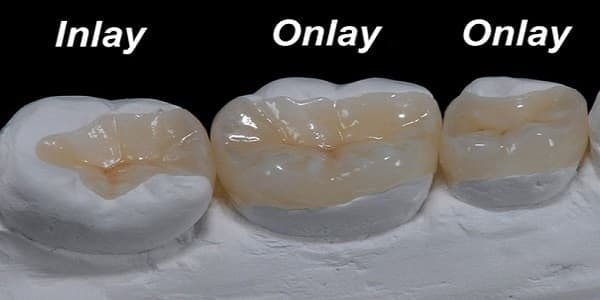We Use Time Tested Restoration Like Inlays And Onlays in Our Day to Day Practice
Inlays and onlays do not require removal of healthy portion of tooth and thus helps in preservation of natural tooth structure


Inlay is an indirect (laboratory made) restoration used to restore posterior decayed or damaged teeth, in which the damaged portion is too extensive to be treated with simple filling. It will incorporate and restore chewing surfaces of the teeth between the cusps.
While onlay is an indirect (laboratory made) restoration which is used to restore posterior decayed or damaged teeth, in which the damaged portion is not extensive enough to need a full coverage crown. Onlays will restore and incorporate one or more cusps.
Based on the nature of material used in their fabrication, inlays and onlay can either be gold type, porcelain type, composite type and zirconium type. Porcelain, zirconium and composite inlays are much more aesthetically appealing than the gold ones due to their close resemblance to the natural tooth color.
Inlays and onlays do not require removal of healthy portion of tooth and thus helps in preservation of natural tooth structure. Inlays and onlays are a more conservative procedure compared to dental crown, helping preserve more natural tooth structure. Porcelain and zirconium inlays do not chance color over time and are aesthetically appealing. Margins of both inlays and onlays are kept minimal which makes them easier to clean and further help in maintaining proper oral hygiene. Moreover they restore and strengthen the damaged tooth.
Gold inlay and onlay are made to order in a laboratory and then cemented into place. Gold inlays are well tolerated by gum tissues, and may last more than 20 years. For these reasons, many authorities consider gold the best filling material. However, it is often the most expensive choice and requires multiple visits.
Porcelain inlays or onlays and are produced to order in a lab and then bonded to the tooth. They can be matched to the color of the tooth and resist staining. A porcelain restoration generally covers most of the tooth. Their cost is similar to gold. This is the most widely used inlay or onlay at our dental center.
Perfect Dental® is known to incorporate latest dental technologies in our clinic and therefore we use the latest CAD/CAM technology to design and fabricate a custom inlay or onlay. This means you can leave the dental office with fully aesthetically restored tooth.
With the right dental care, inlays and onlays can last you 20 to 30 years. You should avoid eating overly sticky or hard foods to ensure that your teeth and the restoration are properly cared for.
Since the process usually takes at least a week, your dentist will fit a temporary inlay or onlay on the tooth to protect it while you wait for the permanent onlay. During the first visit, your dentist will also guide you over your options regarding the material you want to use for the inlay or onlay.
An inlay will not involve any cusp and is cemented in the cavity while onlay will involve one or more cusps being covered. If all cusps and the entire surface of the tooth is covered this is then known as a crown. Historically inlays and onlays will have been made from gold and this material is still commonly used today. Aesthetic inlay or onlay is made using porcelain or zirconium to match with the tooth that is going to receive it.
Just like with dental fillings, inlays and onlays can fall off your tooth. They use a similar bonding process, so years of temperature changes and pressure from chewing all the time can take their toll.
Perfect Dental® is the best dental clinic in Jamnagar and our team of specialist doctors is highly skilled and experienced best dentists in Jamnagar. We have a highest success rate of 97%.